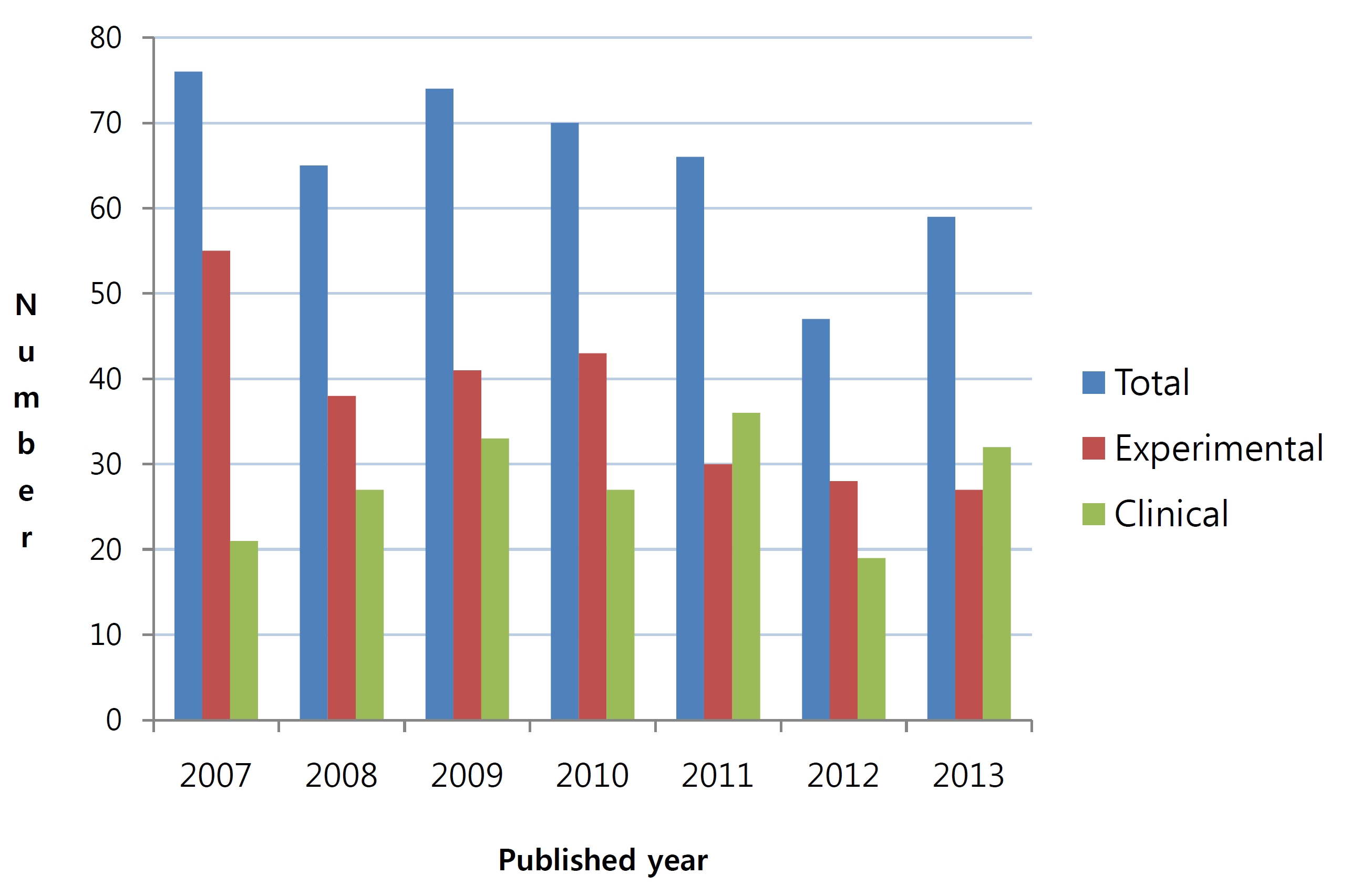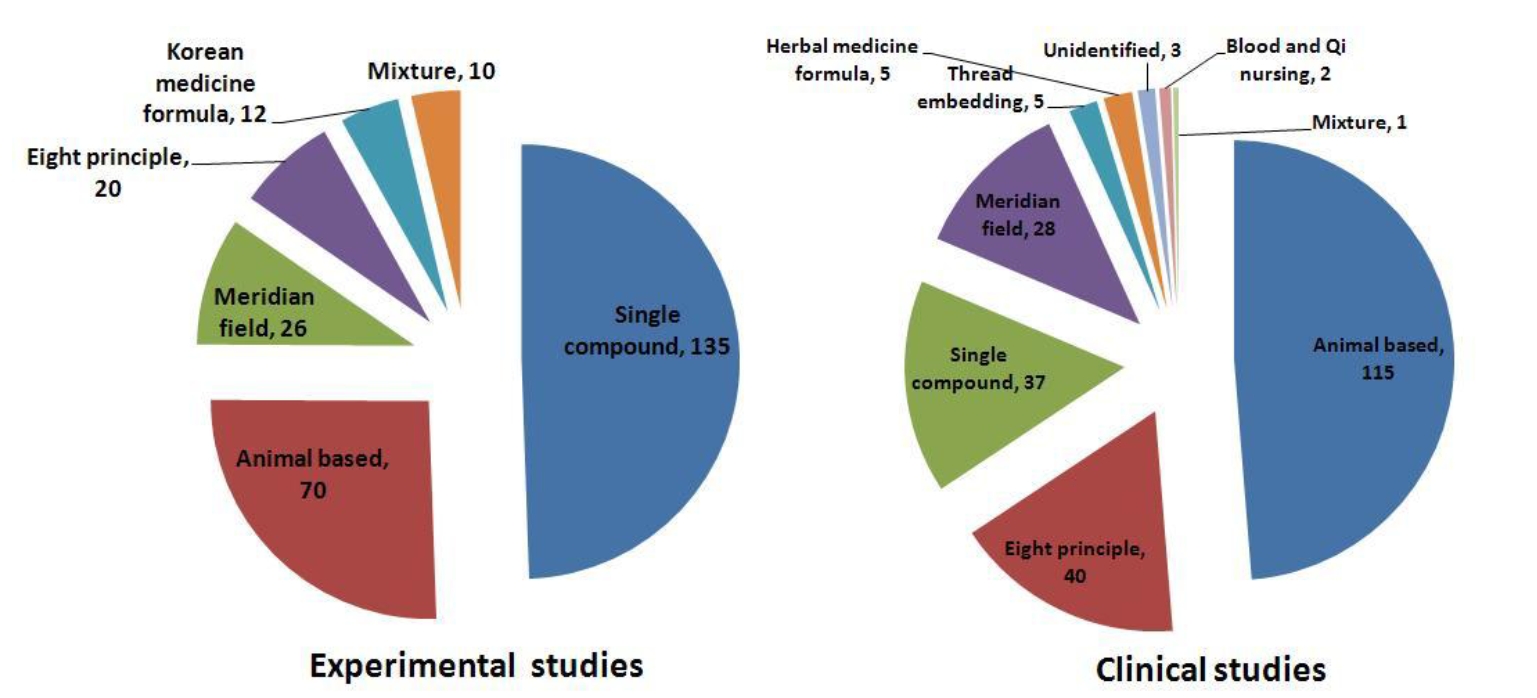



Pharmacopuncture is a new form of acupuncture treatment that combines acupuncture and herbal medicine. Acupuncture is based on the meridian theory, and herbal medicine is based on Qi and flavor theories; thus, pharmacopuncture uses both meridian and Qi/flavor theories. The selection of a specific herbal medicine is based on Qi/flavor theory, and the selection of the acupoint is based on meridian theory, making pharmacopuncture a unique application of traditional Korean medicine (TKM) [1]. Pharmacopuncture has been used and studied widely in Korea since the fundamental principle of pharmacopuncture, which administers a specific herbal medicine at a specific point, was introduced in 1967 by Nam [2] because pharmacopuncture can be used to treat various diseases, depending on to the characteristics of the components of the herbal medicine and the method used to manufacture the pharmacopuncture [2, 3].
A review of pharmacopuncture papers published until 2006 [3, 4] revealed that a variety of research on pharmacopuncture involved experimental and clinical studies. Animal-based pharmacopuncture (ABP), including bee venom pharmacopuncture (BVP), Scolopendra, and placenta pharmacopuncture (PP), meridian field pharmacopuncture (MFP), and eight-principles pharmacopuncture (EPP), accounted for a large proportion of the pharmacopuncture studies. Among them, BVP especially was an outstanding research field. Pharmacopuncture studies for musculoskeletal diseases accounted for the largest part of the research. Also, mountain ginseng pharmacopuncture (MGP), a new pharmacopuncture that has been used in Korean medical clinics as a part of various pharmacopunctures, has been developed [5]. As a natural follow-on study, we wondered how the research trend on pharmacopuncture has changed since the review in references [3, 4]. Thus, we researched the types and the trends of experimental and clinical studies on pharmacopuncture through an analysis of papers published in journals in Korea from 2007.
To review current research articles, we used four databases in South Korea, ‘Science and Technology Society Village’, ‘Korean Studies Information Service System (KISS)’, ‘National Discovery for Science Leaders (NDSL)’, and ‘Oriental Medicine Advanced Searching Integrated System OASIS)’, to search for papers published from January 2007 to December 2013. Key words were ‘pharmacopuncture’, ‘herbal acupuncture’, ‘aqua-acupuncture’, and ‘bee venom’. We included experimental studies (
First, 517 papers from the 4 databases were reviewed. In the first step, 14 papers that were not related with pharmacopuncture, 10 abstracts without full texts, and 6 letters or newspaper articles were excluded. In the second step, 17 literature reviews, 4 studies on pharmacopuncture using a Western medicine, 5 duplicate files, and 4 other articles were excluded. Finally, we selected 457 papers. The 457 selected papers were classified according to year of publication, type of pharmacopuncture, disease & topic, research type and publishing journal.
The number of papers related with pharmacopuncture per year has fallen since 76 papers were published in 2007. On experimental studies, there were 55 papers in 2007, 38 in 2008, 41 in 2009, 43 in 2010, 30 in 2011, 28 in 2012 and 27 in 2013. However, in clinical studies, there were 21 papers in 2007, 27 in 2008, 33 in 2009, 27 in 2010, 36 in 2011, 19 in 2012 and 32 in 2013. Thus, papers on clinical studies, in general, have been increasing steadily, as opposed to papers on experimental studies (Fig 1).
One hundred fifty pharmacopunctures were studied in 457 papers. We distinguished nine kinds of pharmacopuncture: MFP, EPP, ABP, blood and Qi nursing pharmacopuncture (BQNP), single compound pharmacopuncture (SCP), herbal medicine formula pharmacopuncture (HMFP), mixture pharmacopuncture (MP), thread embedding acupuncture (TEA), and unidentified pharmacopuncture. MP is simply a mixture of some herbs, and HMFP is a pharmacopuncture made by using a herb prescription. SCP (49.5%) and ABP (25.6%) were the most studied pharmacopunctures in experimental studies, and ABP (48.7%) and EPP (16.9%) was the most studied pharmacopuncture in clinical studies (Fig 2) BVP (24.4%) placed first among each pharmacopuncture, followed by PP (4.9%), sweet bee venom (SBV, 4.7%), MGP (4.7%), anti-inflammatory pharmacopuncture (AIP, 4.5%), Cornu cervi parvum pharmacopuncture (CC, 3.3%), hwangyeonhaedoktang pharmacopuncture (HRH, 3.3%), and neutral-natured blood stasis pharmacopuncture (NBP, 2.9%) (Table 1)
Top on the list of diseases involving pharmacopuncture were musculoskeletal diseases (30.0%). Among musculoskeletal diseases, rheumatoid arthritis was the most common disease in experimental studies, as was low back pain in clinical studies. In additional to musculoskeletal diseases, other diseases and topics involving pharmacopuncture included nervous system diseases (15.8%), anti-cancer effects (6.1%), obesity (4.6%), toxicity or safety tests (4.4%), digestive diseases (4.4%), urinary diseases (4.2%), circulatory diseases (4.2%), etc. (Table 2).
Among 195 clinical studies, there were 57 case series, 51 RCTs, 47 case reports, 23 non-RCTs, and 17 other types of 17 papers (Table 3). Based on our search of the Korean databases, since 2007, 45 kinds of journals have published studies on pharmacopuncture. The Journal of Korean Acupuncture & Moxibustion Medicine Society (JKAMMS, 31.9%) had the largest proportion of papers on pharmacopuncture. The other journals with studies on pharmacopuncture were the Journal of Pharmacopuncture (J Pharmacopunct, 22.3%), the Korean Journal of Acupuncture (J Acupuncture, 12.5%), the Journal of Oriental Rehabilitation Medicine (J Oriental Rehab Med, 6.3%), etc. (Table 4).
Because of a decrease in the number of experimental studies, the total number of studies on pharmacopuncture has been decreasing even though the number of clinical studies has remained almost the same or has increased slightly. In 2013, the number of clinical studies was more than that the number of experimental studies. This was thought to be due to the facts that recent studies tended to be clinical rather than experimental and that number of clinical studies was tending to remain constant or to increase slightly. Fifty-three percent of clinical studies were case reports and case series due to the increased use of pharmacopuncture in clinics. RCTs took second place, accounting for 26.6% of clinical studies. RCTs had been increasing from 2007, but started to decrease after 2012, probably because policies and laws on clinical studies had become stricter in Korea, thus having an adverse effect on clinical studies involving pharmacopuncture. Furthermore, a large number of the RCTs showed the effect of not only the pharmacopuncture but other treatments as well, so determining whether the effect was due to the pharmacopuncture alone, the other treatment alone or the combination of the two was difficult. Further single RCT studies on pharmacopuncture are needed.
Papers were published in JKAMMS (31.9%), J Pharmacopunct (22.3%), J Acupuncture (12.5%), and J Oriental Rehab Med (6.3%). These are journals in which acupuncture and pharmacopuncture are important fields of research and journals whose major topics are pain, paralysis, and musculoskeletal diseases.
Types of pharmacopuncture used in experimental studies were SCP (49.5%) and ABP (25.6%), and those used in clinical studies were ABP (48.7%) and EPP (16.9%). These results were similar to those of studies performed before 2007 [3, 4]. SCP accounted for such a large percentage because of it use in various experimental studies. Among ABP, BVP, including SBV, was used 29.1% of all experimental studies. The frequency of using Bee venom has been high since before 2007, and bee venom is still being intensively studied. In the papers reviewed, BVP was used to treat pain, paralysis, and musculoskeletal diseases, which are commonly treated in Korean medical clinics. Diseases that were treated by using pharmacopuncture were musculoskeletal diseases (30%) and nervous system diseases (15.8%). Among the diverse types of pharmacopuncture, BVP and SBV were the most common types found in the reviewed papers.
Among EPP, which was studied second most in clinical study, AIP, HRH, and NBP were studied most while placenta among ABP and CC among MFP were mainly studied in experimental research. Compared to experiments before 2006, new types of pharmacopunctures were being studied in experimental and clinical research: for example, Moxi-Tar pharmacopuncture in experimental research and MGP, TEA, Shinbaro pharmacopuncture, and Astragali Radix pharmacopuncture in clinical research. MGP, an intravenously-injected pharmacopuncture that had been invented recently, seemed to be used in anti-cancer, immunity, and fatigue-recovery studies [5].
[Table. 1] Types of pharmacopuncture in experimental and clinical studies
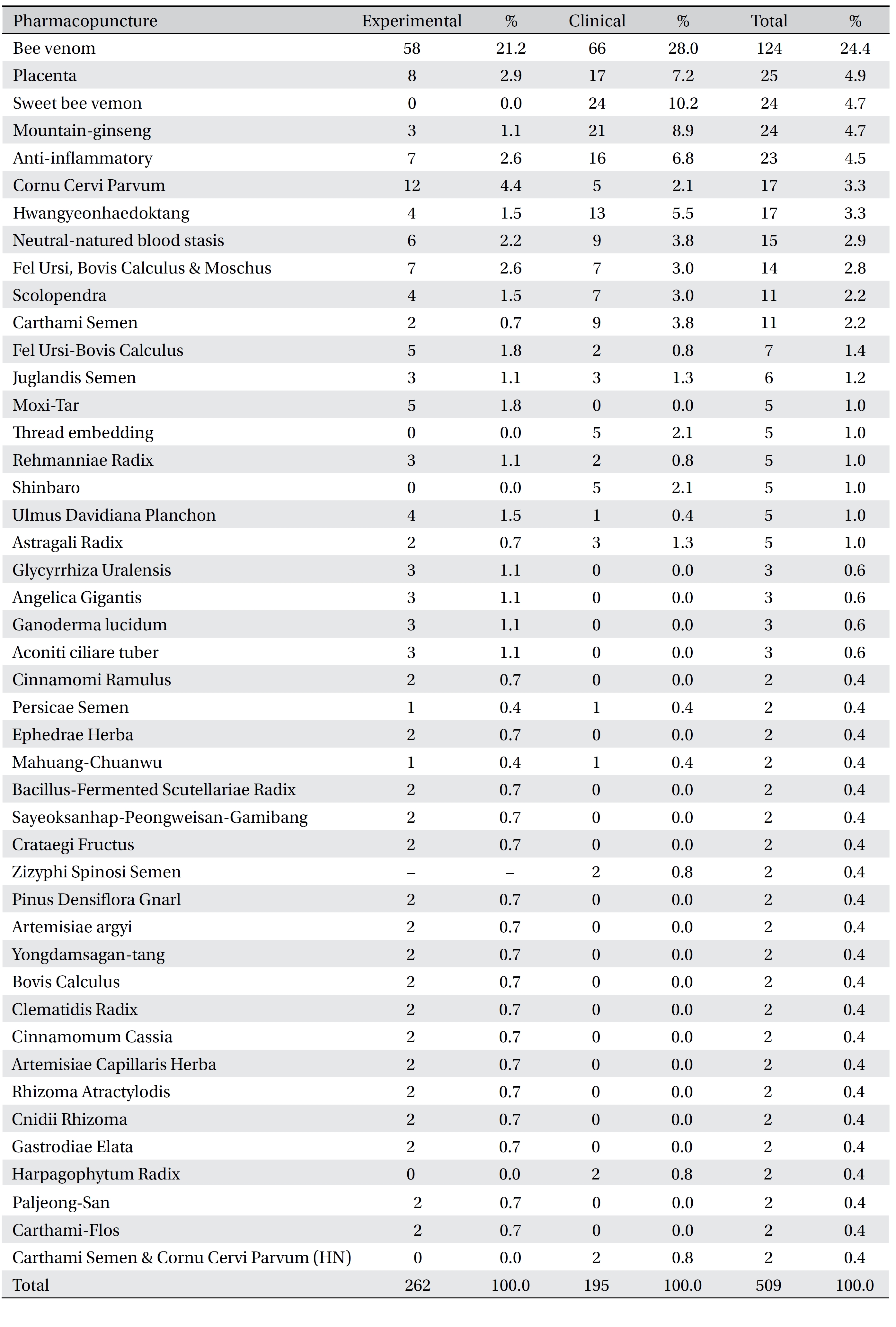
Types of pharmacopuncture in experimental and clinical studies
[Table. 2] Diseases and topics on pharmacopuncture in experimental and clinical studies
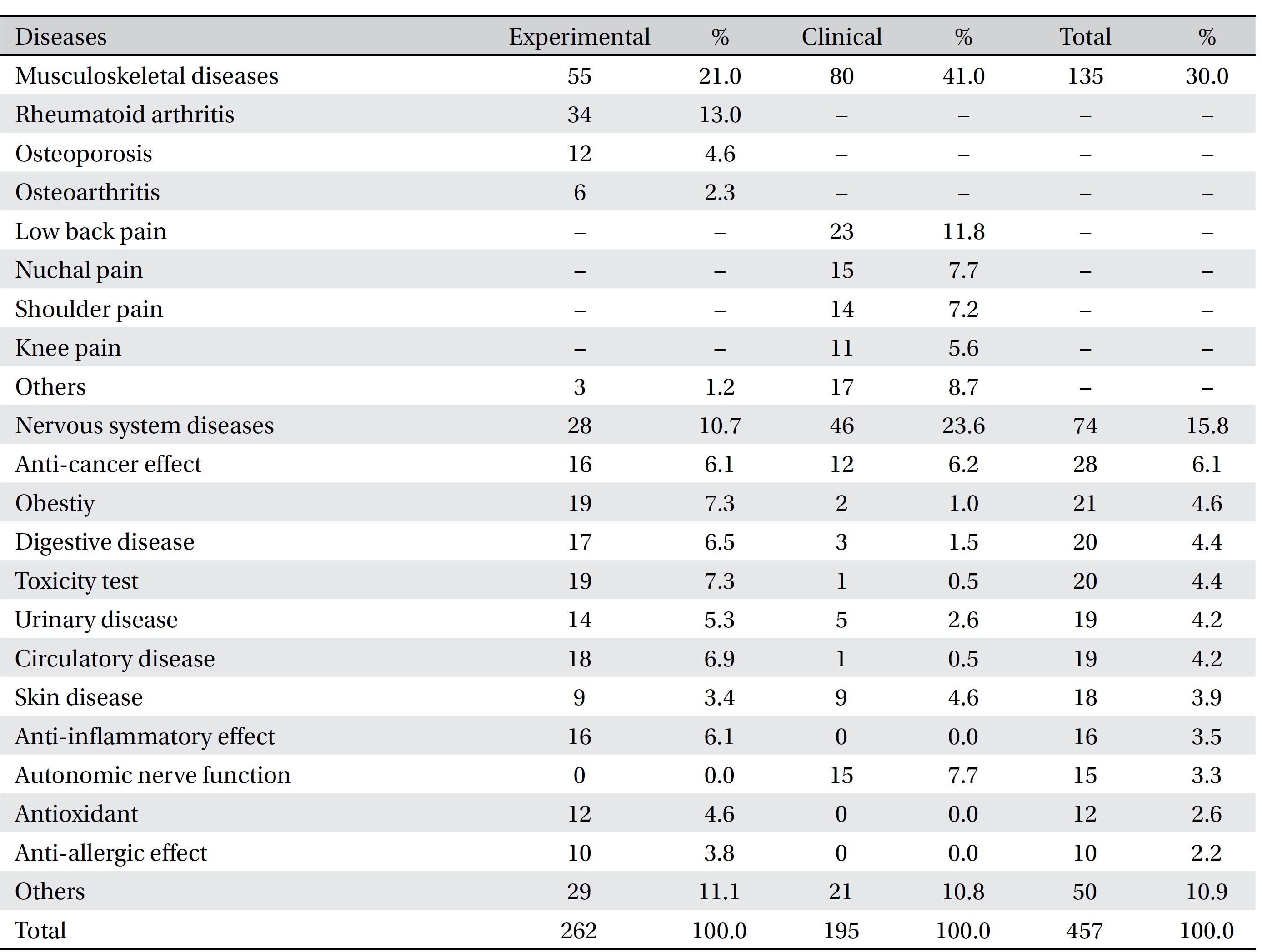
Diseases and topics on pharmacopuncture in experimental and clinical studies
[Table. 3] Research types on clinical studies
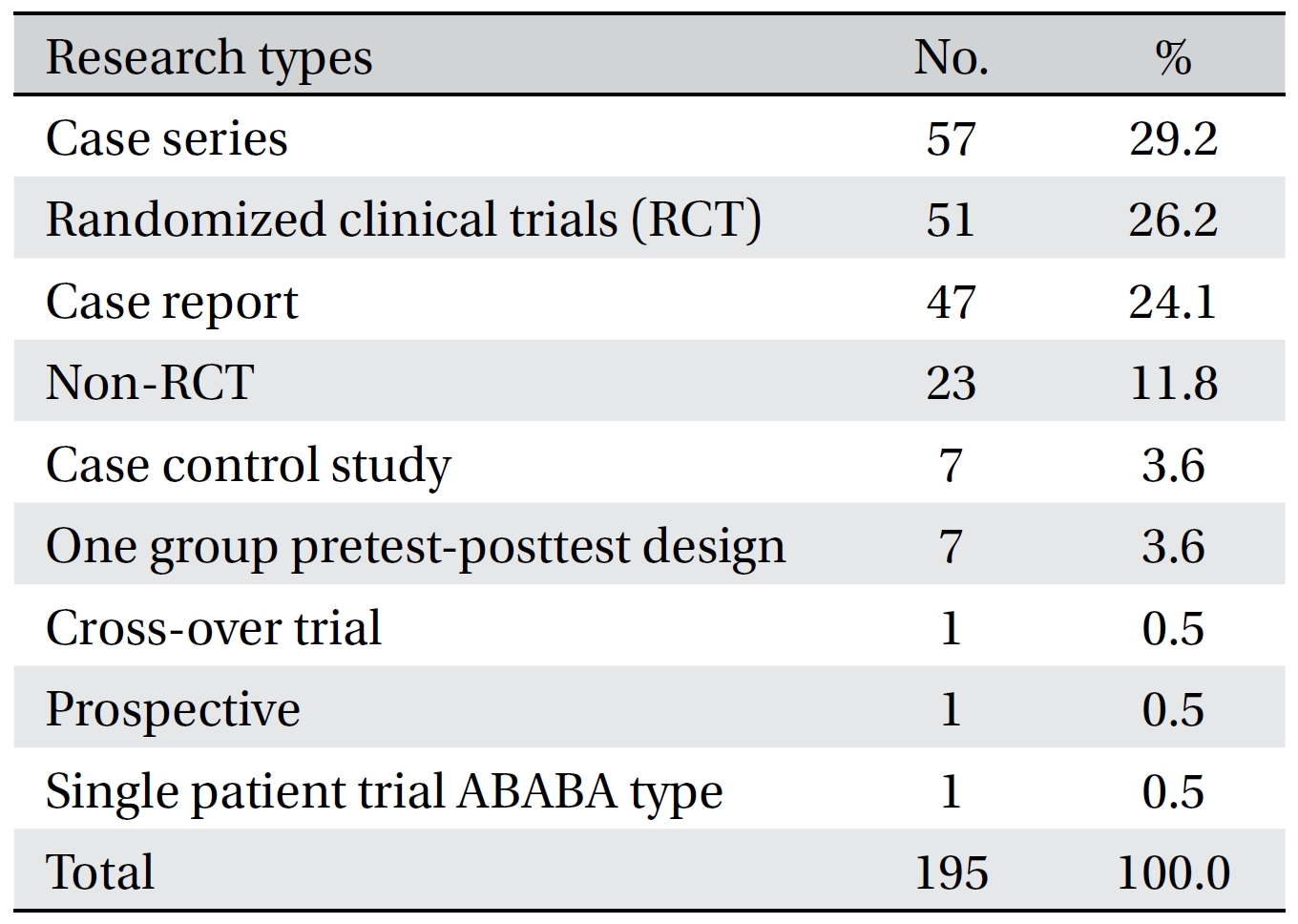
Research types on clinical studies
Of diseases treated by using pharmacopuncture, musculoskeletal diseases were the most (30%) followed by nervous system diseases (15.8%). Pharmacopuncture was also used in studies on anti-cancer effects, obesity, digestive diseases, toxicity tests, urinary diseases, circulatory diseases, skin diseases, anti-inflammatory effects, autonomic functions, and antioxidant and anti-allergic effect, but these studies was very few; thus, further studies are needed in various areas. Also, no studies addressed the mechanism of the pharmacopuncture or its absorption, distribution, metabolism, and excretion of pharmacopuncture. Such studies must be undertaken to ensure the effectiveness and the safety of using pharmacopuncture for the treatment of various diseases and conditions. Because the indications are that pharmacopuncture can be used to treat various conditions, including pain, paralysis and musculoskeletal diseases, additional studies on the use of pharmacopuncture to treat such conditions are needed.
Our review has a major limitation in that it did not to identify the entire trend for pharmacopuncture research accurately because recently the number of papers on pharmacopuncture (especially experimental studies) submitted to or published in well-known non-Korean journals has been increasing, but the papers in our review were restricted to those published in South Korea and involving research done in South Korea because the purpose of our review was to investigate current research trends for pharmacopuncture in South Korea. For the follow-on studies, reviews using global search engines should be consider so that more exact trends can be identified.
[Table. 4] Journals publish in pharmacopuncture studies in Korea from 2007 to 2013
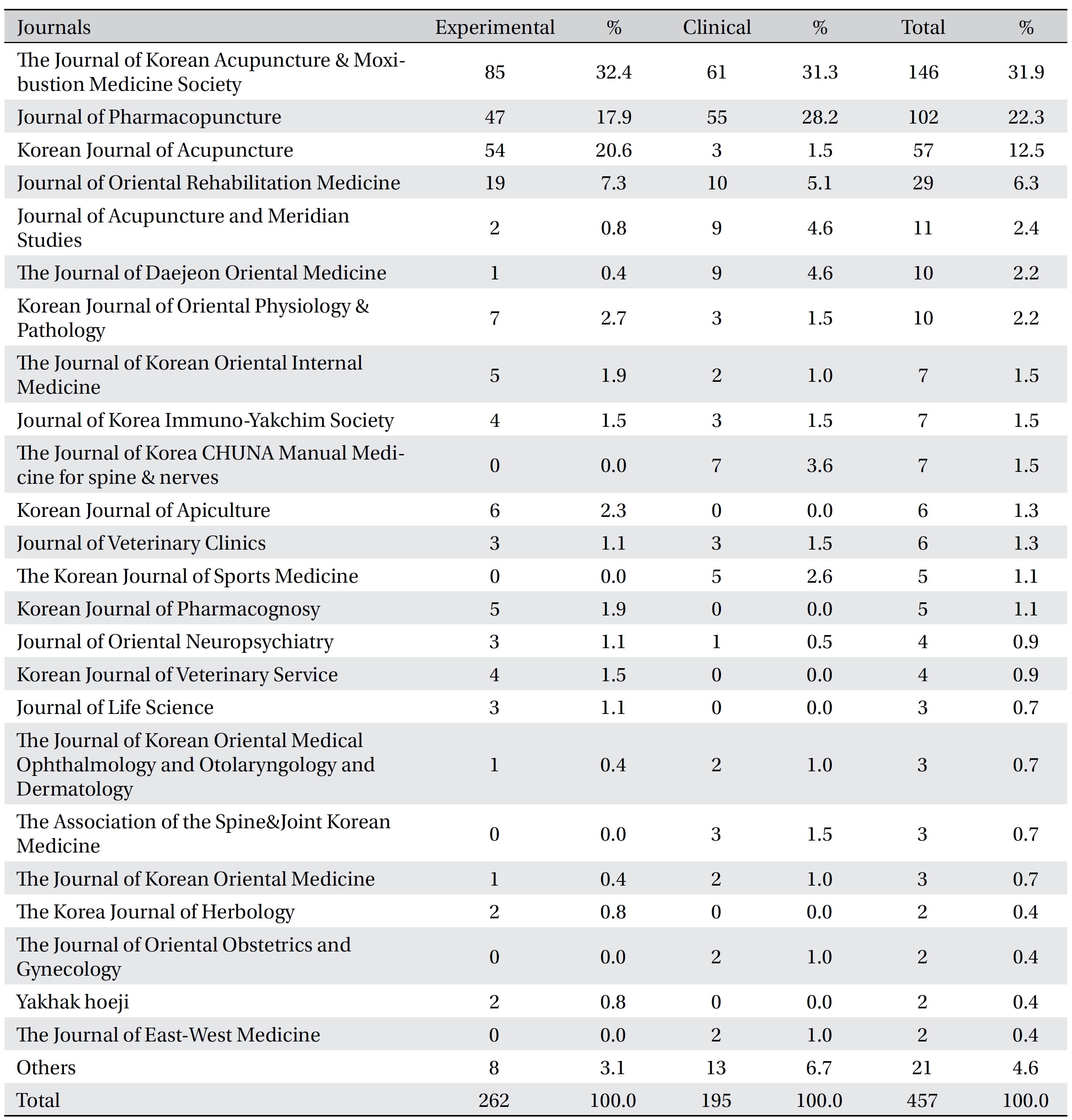
Journals publish in pharmacopuncture studies in Korea from 2007 to 2013
The trends in research on pharmacopuncture published in studies from 2007 to 2013 were similar to those published in studies before 2006. Many studies on pharmacopuncture focused on BVP, pain, paralysis, and musculoskeletal disease in spite of the diverse types of and indications for the use of pharmacopuncture. Additional studies (especially RCTs, studies on mechanisms, etc.) are needed for diverse types of and indications for pharmacopuncture.
